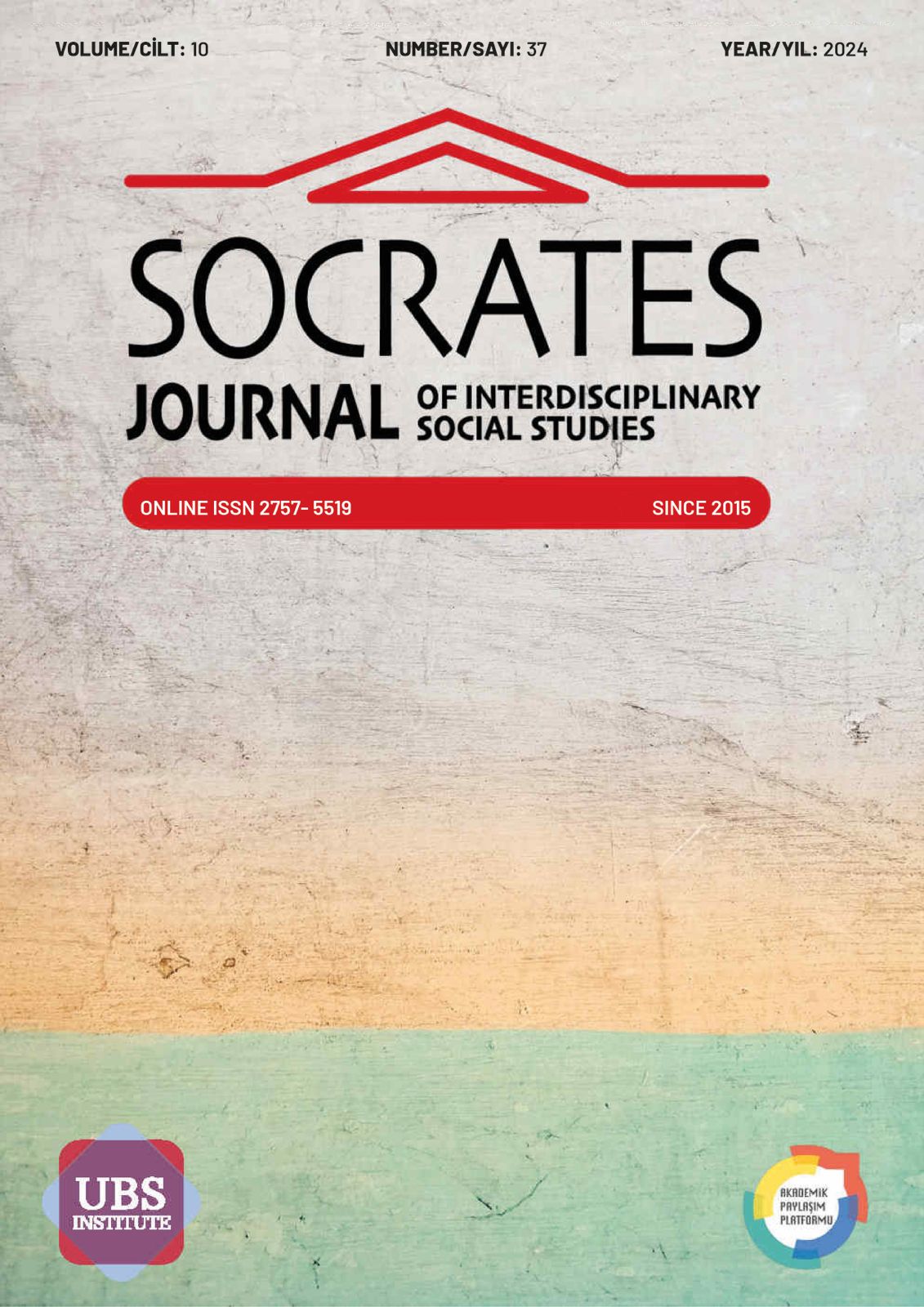TİCARİ META HALİNE GELEN SİMULE ŞÖHRET ÇOCUK YOUTUBERLAR
DOI:
https://doi.org/10.5281/zenodo.10498321Anahtar Kelimeler:
Dijital Şöhret, Tüketim Kültürü, Simülasyon KuramıÖzet
Sanal teknolojide buluşan bireylerin her geçen gün artması ve popülerlik kazanmasıyla dijital şöhret ya da sanal şöhret kavramları ortaya çıkmış ve sosyal sağların yeni fenomenlerin sayılarında ekonomik kazançlar ve genişleyen şöhretleri nedeniyle hızlı bir artış görülmüştür. Tanınır ve popüler olmaya merak insanın egosundan doğan bir istemin barındırdığı bir duygudur. Bu durum yaş farklılığı gözetmeksizin çocuklardan yaşlılara kadar gözlemlenmektedir. Son yıllarda Youtube uygulamasının yükselişe geçmesi ve youtuber olmaktan maddi kazanç sağlaması imkânları nedeniyle sanal ün kazanan fenomenler doğmuştur. Günümüzde ise dijital şöhret çeşitlilik göstermektedir. Yalnızca Youtube ile kalmayıp, Instagram, Facebook gibi sosyal medya uygulamalarında görülmektedir. Milenyum Çağı beraberinde dijital çağı da beraberinde getirmiştir. Şimdi ise Dijital Dünya - Metaverse Çağı geldiği iddia edilmektedir. Bu durum ise çocukları daha çok içine çekmektedir. Özellikle çocuk YouTuberlar bu sanal tüketim kültürü içerisinde kendini kaybetmektedir. Hatta ebeveynler dijital şöhretin sağladığı imkânlardan dolayı resmen kör hale gelmiş, çocuklarını bu mecrada düşüncesizce pazarlama yarışına girişmektedirler. X, Y, Z kuşaklarının asıl problemi geçiş çağında sıkışanlardır. Özellikle günümüzde Z kuşağını kapsayan YouTube'un yükselişiyle birlikte dijital oyunlar, video bloglar, moda ve makyaj videoları yapan ve milyonlarca abonesi olan "YouTube fenomenleri" ortaya çıkmıştır. Bu bireyler genel olarak çocuklar ve gençler arasından ünlü olup özellikle akranlarını etkilemektedir. Sosyal ağ kanalları aracılığıyla onları benzer içerikler üretmeye teşvik edip, ayrıca çocukların ünlü olmalarına da örnek olmaktadırlar. Abone sayısı artırıp bu durumdan kazanç sağlamak uğruna yapılanlar ise tahmin edilemeyecek kadar kendini aşmış haldedir. Baudriallard tüketim kültürü içinde kısa sürede elde edilen gerçek olmayan yapay geçici simule şöhretten bahseder. Bu kapsamda çalışma Baudriallard’ın simülasyon kuramı çerçevesinde şekillendirilecektir. Simülasyon kuramının gerekliliği olan bilinçdışı gözetim ve yönlendirme olgusu, irdelenen videolar ile birlikte bilinçli bir platformun merkezi konumlandırılmış ve henüz reşit olmayan ve bakıma muhtaç çocuklar üzerinden manipülasyonun devamı ile birlikte ticari birer metalar haline getirildiği görülmüştür.
Referanslar
Akyazı, E. (2015). Siyasal Kutuplaşma ortamı olarak sosyal medya: 7 Haziran 2015 genel seçimleri üzerine bir araştırma”, ağdaki şüphe bir medya eleştirisi. İstanbul: Beta Yayınları.
Akyüz, E. (2010). Çocuk Hukuku. Ankara: Pegem Akademi.
Alper, A. (2012). Sosyal Ağlar. Ankara: Pelikan Yayıncılık.
Avcı, Ö. (2015). Dijital Yaşamın Dijital Özne(l)leri: Herkes ya da Hiç Kimse. Uşak Üniversitesi Sosyal Bilimler Dergisi, 249-266.
Aytaç, Ö. (2006). Tüketimcilik ve Metalaşma Kıskacında Boş Zaman. Kocaeli Üniversitesi Sosyal Bilimler Enstitüsü Dergisi, 27-53.
Baudrillard, J. (2011). Simülakrlar ve Simülasyon. (O. Adanır, Çev.) Ankara: Doğu Batı Yayınları.
Baudrillard, J. (2008). Tüketim Toplumu. Çev., Hazal Deliçaylı ve Ferda Keskin. İstanbul: Ayrıntı Yayınları.
Baudrillard, J. (2010). Sanat Komplosu, (çev. Işık Ergüden- Elçin Gen). İstanbul: İletişim Yayınları.
Baudrillard, J. (2001). Tam Ekran, (çev. Bahadır Gülmez, YKY yayınları, İstanbul
Crystal, A. (2018). Internet Celebrity: UnderstandingFame Online. Jönköping University, Sweden: Emerald Publishng.
Çaycı, B. ve Aktaş, C. (2018). Medya Çağında Weberyen Karizma ve Şöhretin Analojisi. TRT Akademi, 654 - 676.
Dağtaş, B. ve Dağtaş, E. (2009). Medya, Tüketim Kültürü ve Yaşam Tarzları . Ankara: Ütopya Yayınları.
Gardner, H., & Davis, K. (2013). App kuşağı dijital dünyada kimlik, mahremiyet ve hayal gücü. İstanbul: Optimist Yayınları.
Holderman, L. (2007). Ozzy Worked for Those Bleeping Doors with the Crosses on Them’: The Osbournes as Social Class Narrative.”, (Ed: Redmond S.& Holmes S.), Stardom and Celebrity: A Reader. S. Redmond, & S. Holmes içinde, Stardom and Celebrity: A Reader (s. Chapter 24). SAGE Publications Ltd.
Jarvis, J. (2012). E-sosyal toplum. Dijital çağda sosyal medyanın iş ve gündelik hayata etkisi. (çev. Çağlar Kök). İstanbul: MediaCat Yayınları.
Jorge, A., & Marôpo, L. (2017). Childhood and Celebrity . Born to be famousChildren of celebrities and their rights in the media (s. 28-40). içinde London, United Kingdom: Routledge.
Laughey, D. (2010). Medya çalışmaları - teoriler ve yaklaşımlar. İstanbul: Kalkedon.
Marshall, P. D. (1997). Celebrity and power. London: University of Minnesota.
McLuhan, M. (2005). Yaradanımız medya- medyanın etkileri üzerine bir keşif yolculuğu. İstanbul: Turkuvaz Kitap.
Mutlu, B. (2017). Sosyal medya pazarlamasının yeni yüzleri youtube içerik üreticileri ve kanal toplulukları: Youtuber - marka işbirliği videoları üzerine bir araştırma. Yüksek Lisans Tezi, Ege Üniversitesi, İzmir.
O’Connor, J. (2017). Childhood and celebrity. Mapping the Terrain. içinde Routledge.
Omay, U. (2009). Emeğin Kültür ve Manipülasyon Teorisi . İstanbul: Beta Yayınları.
Önk, Ü. (2009). Baudrillard Perspektifinden Bir Kitle İletişim Ve Sanat Aracı Olarak Simülasyon Evreninde Televizyon. Selçuk İletişim, 201-218.
Robb, M. B., & Sense, C. (2020). Teens and The News: The Influencers, Celebrities and Platforms They Say Matter Most. San Francisco: CA: Common Sense Media.
Rojek, C. (2003). Şöhret, (Çev. Semra Kunt Akbaş, K.S. & Kızıltuğ, K.) . İstanbul: Ayrıntı Yayınları.
Ruddick, G. (2017, Ağustos 3). The ‘sharenting’ divide: half UK parents do not post children’s pictures. theguardian: https://www.theguardian.com/uk-news/2017/aug/03/the-sharenting-divide-half-uk-parents-do-not-post-childrens-pictures. adresinden alındı
We Are Social. (2020). Digital in 2020. https://wearesocial.com/digital-2020, 18.12.2021.
Whitehead, D. (2014). The Evidence of Things Unseen: Authenticity and Fraud in the Christian Mommy Blogosphere. Journal of the American Academy of Religion , 120-150.
Ying, H. (2007). Youtube Gerçek Öyküsü . İstanbul: Pegasus Yayınları.
Yüksel, M. (2003). Mahremiyet hakkına ve bireysel özgürlüklere felsefi yaklaşımlar. Ankara Üniversitesi SBF Dergisi, 5-11.
Zolides, A. (2017). Conceptualising the child as media producer. Jane O’Connor ve John Mercer (Ed.), içinde, Childhood and celebrity (s.147-158). Routledge.
https://www.commonsensemedia.org/sites/default/files/uploads/research/20 20_teensandnews-fullreport_final-release-web.pdf, 18.12.2021.
https://www.hurriyet.com.tr/dunya/ne-enes-batur-ne-de-danla-bilic.-prenses-elif-tam-2-5-milyar-kez-izlendi-40752648, 18.12.2021.
https://eksisozluk.com/prenses-elif--5236805?p=1, 18.12.2021.
https://www.youtube.com/watch?v=CMNafxGmycA, 18.12.2021.
https://eksisozluk.com/prenses-elif--5236805?p=1, 18.12.2021.
İndir
Yayınlanmış
Nasıl Atıf Yapılır
Sayı
Bölüm
Lisans
Telif Hakkı (c) 2024 Socrates Journal of Interdisciplinary Social Studies

Bu çalışma Creative Commons Attribution 4.0 International License ile lisanslanmıştır.


